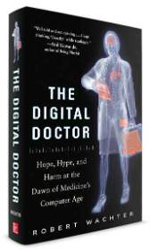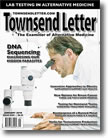|
We've all heard about the many ways that digital medical records will improve our health-care system. They could solve the problem of lost charts. They could eliminate errors due to sloppy physician handwriting.
But over the past few years, I've noticed that electronic health records also have their problems. The last time I saw my primary care physician, she began by checking my personal history, and we found that certain facts had been distorted when the practice switched from paper to digital records. My medication list was slightly inaccurate, because the options in the electronic chart don't exactly match the medications that I'm actually using. Also, I was particularly concerned to notice my doctor doing data entry during our conversation at a fixed-height desk, with her hands in an inappropriate, potentially harmful position for typing.
Recently I read a new book by Robert Wachter, MD, and realized that the small problems which I've noticed in my own experience are just tiny signals about major issues reverberating through the entire health-care system as we transition to electronic health records. While these records certainly have benefits, and eliminate some familiar problems, they also introduce new problems.

Wachter is a respected academic physician, serving as professor and interim chair of the Department of Medicine at the University of California, San Francisco. He's the author of an important textbook on health-care quality and patient safety. His new book, The Digital Doctor: Hope, Hype, and Harm at the Dawn of Medicine's Computer Age, introduces readers to the many different personalities, organizations, and interests shaping digital medicine.
When Wachter first mentioned on his blog that he was working on this book, I expected it to be a valuable but somewhat dry textbook. Months later, when I came across a few chapters while browsing the Internet, I couldn't stop reading.
The Overdose
In 2013, a teenager at Wachter's hospital received 38.5 antibiotic pills. The correct, intended dose was one pill. He went into convulsions and almost died.
In eight chapters, Wachter explores the many different factors that led to this event. The computer ordering system used weight-based dosages for pediatric patients without clearly highlighting this, so it was all too easy for a physician to order "160 mg per kilogram" instead of the total 160 mg that was intended. The computerized system also used an alert system for possible errors, but nowadays there are so many alerts (in the chart and also on every medical device) that practitioners often ignore them. An automated robot actually dispensed the medication, and everyone assumed that the robot would be far more accurate than a human being, so it could not make an error.
When the nurse on the unit received 38½ antibiotic pills to dispense, she paused to wonder if this could possibly be correct. But she was working in an academic institution that often dispenses unusual medications. She was under extra stress that night because she was "floating," working on an unfamiliar unit. "Another factor was her rush to complete her tasks," Wachter writes. "She also didn't want to bother the busy charge nurse. ... As is so often the case with medical mistakes, the human inclination to say 'it must be right' can be powerful."
About 6 hours after ingesting the medication, the patient blacked out, began seizing, and stopped breathing. Fortunately the hospital's Code Blue team was able to quickly revive him. He spent several days in the ICU, but has not experienced long-term effects from the overdose.
Reading this section of the book is a gripping experience. UCSF Medical Center is one of the best hospitals in the country. It was and is committed to first-class health care, including the best possible digital systems. All of the staffers involved in the overdose were intelligent, committed people trying to do the best work possible under the circumstances. Yet the error still occurred. It makes you stop and think about the unexpected, unintended consequences of the digital transformation.
One important aspect of this story is that it propelled Wachter into writing the book, with full support from the leadership at UCSF. "Being transparent about such a case is an act of individual and institutional bravery," he writes. "The nurse, the physician and the pharmacist all agreed to speak with me about this terrible incident because they knew that doing so could save lives."
In the past, other industries, such as the airlines, have led the way by setting high safety standards and exhaustively exploring the root causes of any disaster. When a book like this can publicly explore the many causes behind one major medication error, it gives us hope for increased transparency and quality improvement in health care.
Exploring Digitized Health care from Many Different Angles
The Digital Doctor explores the effects of electronic health records from many different angles. Digitizing records changes the social environment. Physicians are tied to their computer screens, and miss some of the informal social interactions, with patients and with other physicians, that have been so valuable in the past.
The chart used to be the physician's record of information needed to offer appropriate care. Nowadays computerized charts are used for many additional functions, such as research and billing. This means that it can be more difficult for the physician to quickly grasp the most essential information on a patient. Wachter describes one primary care physician's experience: "Because the computer system doesn't allow Sinsky to navigate the patient's record in an intuitive way ... her staff spends hours the day before every clinic session printing out most of the electronic record. It's the only way she can see what she needs to see."
Unfortunately, the current crop of electronic health records often requires physicians to enter information in convoluted, clunky, time-consuming ways. Wachter tells stories that are both funny and horrifying, about physicians who point out major flaws in their hospital's EHR systems, expecting to be thanked for their useful comments. Instead they are often rebuffed and even ostracized.
Wachter describes efforts to make medical records more open and available to patients. Susan Edgman-Levitan, a leader in the field of patient communication, reviewed her own record and found a major error. A radiologist's report left out the word "no," so it said exactly the opposite of the intended meaning. She was concerned because this could affect her care if she found herself unconscious in the ER. It took several months plus a couple of committee meetings to correct her record. In general she finds that when patients review their charts, they often discover significant errors.
Wachter includes a section on the players and policies in digital health care, reviewing incentives for various forms of medical records. He describes meetings with Silicon Valley entrepreneurs brainstorming new technical possibilities. One of the major pleasures of this section, and of the book as a whole, is seeing isolated news stories within a larger context. Suddenly, many specific headlines about changes in payment methods or physician frustration with new charting methods all fit together and make sense.
Throughout the book, Wachter emphasizes that using digital technology requires major changes in work flow – that we are only at the start of a transformational process. "It turns out that new technologies always rearrange social relationships," he writes. "Perhaps it was naïve of us to believe that the first versions of these technologies would be perfect. ... After all, before there was the iPad there was the Newton. ... We're simply not smart enough to make it from A to Z without going through the rest of the alphabet first."
If you are interested in how and why our health-care system works now, and how it may change in the future, read this book.
Resources
 Books Books
Wachter R. The Digital Doctor: Hope, Hype, and Harm at the Dawn of Medicine's Computer Age (McGraw-Hill; 2015). Several chapters about the overdose are posted on the Internet, at http://bit.ly/1DHij1W.
———. Understanding Patient Safety (McGraw-Hill; 2nd edition 2012). A lively, up-to-date primer on patient safety, full of case vignettes, tools, references, and other key resources.
Blog
Wachter posts occasional comments and sparks interesting discussions on his blog, Wachter's World, at http://community.the-hospitalist.org.
Elaine Zablocki has been a freelance health-care journalist for more than 20 years. She was the editor of Alternative Medicine Business News and CHRF News Files. She writes regularly for many health-care publications.
|
![]()
![]()
![]()






